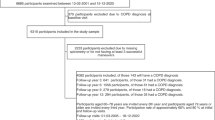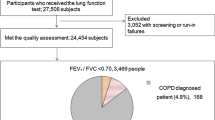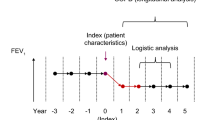Abstract
Current COPD guidelines such as the GOLD workshop report use a fixed FEV1/FVC value (0.70) to define airway obstruction, and FEV1 % predicted to classify COPD severity. Evidence is emerging that this approach leads to an unacceptable percentage of false-positive diagnoses of mild and moderate COPD. Expressing FEV1 as a percent predicted value similarly introduces a bias: small people, elderly people, and especially small elderly people who are in good respiratory health will be incorrectly identified as having an abnormally low FEV1. More appropriate classification rules for defining the presence and severity of airway obstruction are urgently needed, especially for primary care doctors who have to deal with the early stages of COPD. The use of the lower limit of normal (LLN) for the FEV1/FVC ratio instead of a fixed ratio value of 0.70 would be a first rational step towards a better classification of airway obstruction.
Similar content being viewed by others

Article PDF
Author information
Authors and Affiliations
Corresponding author
Ethics declarations
Competing interests
There were no conflicts of interest for the authors in the preparation of this paper.
Rights and permissions
About this article
Cite this article
Schermer, T., Quanjer, P. COPD screening in primary care: who is sick?. Prim Care Respir J 16, 49–53 (2007). https://doi.org/10.3132/pcrj.2007.00012
Received:
Accepted:
Published:
Issue date:
DOI: https://doi.org/10.3132/pcrj.2007.00012
This article is cited by
-
Should the diagnosis of COPD be based on a single spirometry test?
npj Primary Care Respiratory Medicine (2016)
-
COPD-screening bij ouderen heeft weinig effect
Huisarts en wetenschap (2015)
-
Spirometrie in de eerste lijn
Bijblijven (2007)


